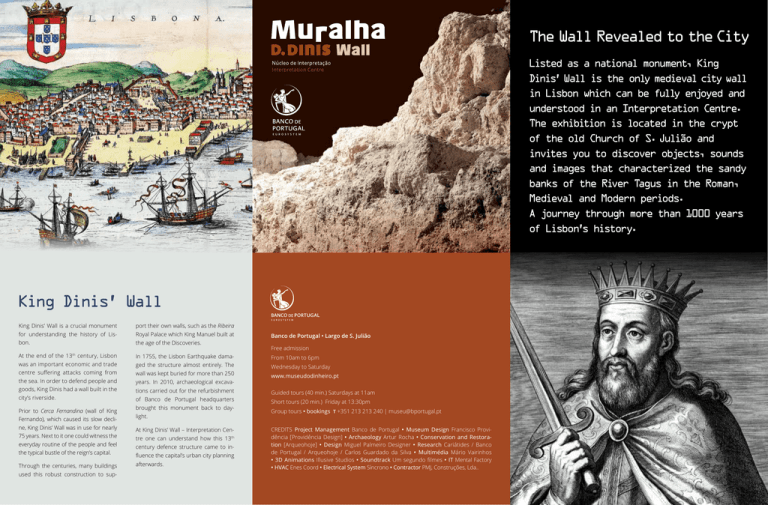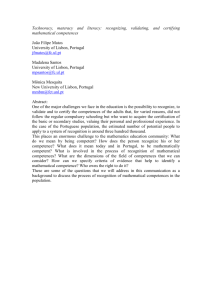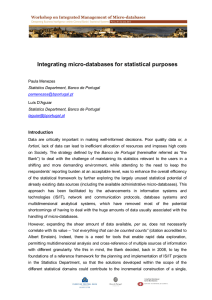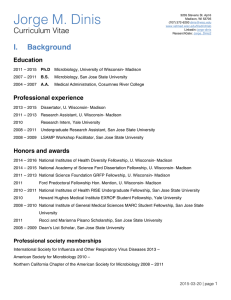The Wall Revealed to the City
advertisement

The Wall Revealed to the City Listed as a national monument, King Dinis’ Wall is the only medieval city wall in Lisbon which can be fully enjoyed and understood in an Interpretation Centre. The exhibition is located in the crypt of the old Church of S. Julião and invites you to discover objects, sounds and images that characterized the sandy banks of the River Tagus in the Roman, Medieval and Modern periods. A journey through more than 1000 years of Lisbon’s history. King Dinis’ Wall King Dinis’ Wall is a crucial monument port their own walls, such as the Ribeira for understanding the history of Lis- Royal Palace which King Manuel built at bon. the age of the Discoveries. At the end of the 13th century, Lisbon In 1755, the Lisbon Earthquake dama- was an important economic and trade From 10am to 6pm ged the structure almost entirely. The centre suffering attacks coming from wall was kept buried for more than 250 Wednesday to Saturday the sea. In order to defend people and years. In 2010, archaeological excava- goods, King Dinis had a wall built in the city’s riverside. Prior to Cerca Fernandina (wall of King Fernando), which caused its slow decline, King Dinis’ Wall was in use for nearly 75 years. Next to it one could witness the everyday routine of the people and feel the typical bustle of the reign’s capital. Through the centuries, many buildings used this robust construction to sup- tions carried out for the refurbishment of Banco de Portugal headquarters brought this monument back to daylight. At King Dinis’ Wall – Interpretation Centre one can understand how this 13th century defence structure came to influence the capital’s urban city planning afterwards. Banco de Portugal • Largo de S. Julião Free admission www.museudodinheiro.pt Guided tours (40 min.) Saturdays at 11am Short tours (20 min.) Friday at 13:30pm Group tours • bookings T +351 213 213 240 | museu@bportugal.pt CREDITS Project Management Banco de Portugal • Museum Design Francisco Providência [Providência Design] • Archaeology Artur Rocha • Conservation and Restoration [Arqueohoje] • Design Miguel Palmeiro Designer • Research Cariátides / Banco de Portugal / Arqueohoje / Carlos Guardado da Silva • Multimédia Mário Vairinhos • 3D Animations Illusive Studios • Soundtrack Um segundo filmes • IT Mental Factory • HVAC Enes Coord • Electrical System Síncrono • Contractor PMJ, Construções, Lda.. KING DINIS FROM FRAGMENTS TO ARTIFACTS The long reign of King Dinis (1261-1325) saw him become one of the most important monarchs of his time. He established Portugal’s borders and strategically boosted both domestic and international trade. He was responsible for the considerable Traces of human presence stretch LISBOA CENTRE OF CULTURE The reconquest of Lisbon, back to nearly 2000 years ago. Among more than 100 000 ceramic TIME NARRATED BY ARCHAEOLOGY importance given at that time to education, in 1147, brought considerable culture and the Portuguese language. economic growth. The city Archaeological works enabled developed to the outskirts of the possibility to characterize the Cerca Moura (Moorish wall) the development of Lisbon’s left by the king. Video animations towards the Baixa valley. Baixa area from the time present King Dinis’ genealogy, Lisbon became an important The soundtrack of the exhibition enhances the troubadour legacy the Treaty of Alcanizes, among other images and documents commercial and cultural hub of the Roman Empire to the present. in Europe and its court one Visual records document the of the biggest literary centres work process step-by-step. in the Iberian Peninsula. All-around sounds resonate The medieval city is presented medieval times, recreating fast growing international through images and documents the everyday life of the transactions taking place that illustrate late-medieval urban markets and of the crafts in Portugal. design, trade and professions. of a moving city. of the time. Portuguese and French coins – tornês, dinheiro and gros tournois – illustrate the Amulet | 18th to 19th century. This type of object, already known in Classical Antiquity, was originally a symbol of a sexual nature. Over time, the symbolism evolved and it became an amulet to protect against the evil eye. fragments recovered by archaeology most belong to the Roman and Islamic periods. Objects on display witness the commercial and maritime natural potential of Lisbon. 3D animations virtually reconstruct each object, thus completing the information regarding its shape, texture and purpose. Tornês 1279-1325 | Silver Gros Tournois 1226-1270 | Silver Dinheiro 1279-1325 | Billon This unexpected part of the wall reveals historical material evidence, such as the original, coarse and damaged covering of the footing, and – in a well defined upper strip – the wall covering of the Ribeira Royal Palace built in the 16th century. The sounds perceived enhance the room and refer us to the sandy banks of the Tagus, the strength of the waves and boats, and to the seagulls flying over the Tagus. Tile | 16th century. Tile with a polychrome geometrical design made using the typically Mudéjar, dry-string technique, which was very popular in the early 16th century. It is believed that it belonged to one of the rooms of the old Ribeira Royal Palace, which went all the way up to the King Dinis’ wall. Pombaline Stake | 2nd half of the 18th century. This item belongs to the structure of the building of Banco de Portugal. These pine stakes were driven vertically under the foundations of the building and used to stabilise the ground and the walls. The entire block rests on pieces like this one, typical of the architectural solutions of the Pombaline period. THE WALL Tower | 10th to 13th century. Fragment of the top of a tower decorated with geometric motifs. The base is missing, making it impossible to clearly identify its nature. It may have been a chess piece or the tip of a distaff. Mortar | 1st half of the 2nd century AD. Fragment of the rim of a mortar stamped with the words “DIONYS(I) DOM LUCILI”. It indicates that it was made by the potter Dionysius in the workshops belonging to the emperor Marcus Aurelius’ mother, Domitia Lucilla. Crack in the plasterwork | A diagonal crack in the plasterwork that stretches from the top of the footing to the upper part of the wall. It is a likely consequence of seismic activity, possibly the 1755 earthquake. Pombaline Well | The Pombaline well was built after 1755, when the wall was already buried and traffic circulated almost at the same ground level as today. Wells provided water (sometimes drinkable) for domestic use and above all ensured sufficient supply to fight fires in the city. Ceramic wall covering | Ceramic wall covering possibly from one of the rooms of the Ribeira Royal Palace which absorbed King Dinis’ Wall in the 16th to 18th centuries.



